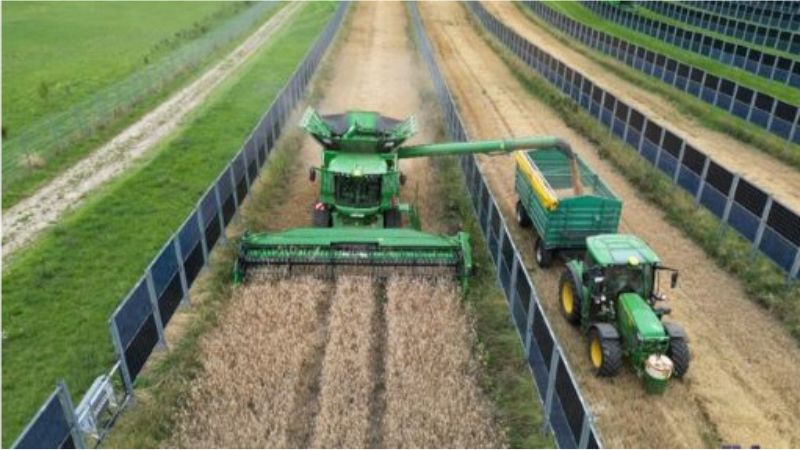Exploring Bifacial Solar Panel Advantages From Every Angle
Most solar panel installations only include horizontal panels, but bifacial vertical solar panels could offer distinct advantages because they can capture sunlight for an extended time.
The flat, horizontal solar panel has dominated solar energy, but engineers are pioneering new solar technologies for use where conventional solar panels aren’t suitable. One development is the vertical bifacial solar panel, which can be installed in population-dense areas or agricultural settings.
Bifacial solar panels can maximize the number of hours panels capture sunlight because their dual panels absorb the sun’s rays in the morning and early evening.

Bifacial vertical solar panels. Imaged used courtesy of Sandia National Laboratories
Advantages of and Opportunities for Bifacial Vertical Panels
For most horizontal installations, the panel’s angle is relative to the slope of the ground, and angles tend to be modest. The angle range for horizontal panel installations is usually between 20 and 35 degrees. This facilitates sun capture during a single window of time when the sun is midday and directly above the installation. If horizontal panels only have one performance peak, the energy must be stored for later use.
A vertical panel stands at 90 degrees and maximizes energy capture throughout the day rather than at one peak time. This continuous energy capture is particularly useful because it reduces the storage burden.
The advantages of bifacial vertical panels are apparent in the data. One study shows vertical panels offer up to 11% more energy than the horizontal alternative. If the vertical panel is paired with tracking capabilities, and the panel angle is slightly angled, the energy yield climbs significantly to 27%.
Bifacial solar panels capture sun energy from multiple angles. Image used courtesy of NREL
Vertical panels are ground-mounted, and installation can be expensive, but commercial installations may be able to capitalize on the long-term advantages of increased energy yield.
In comparing the costs of bifacial and monofacial manufacturing, the National Renewable Energy found the bifacial option is more expensive, mostly because of materials and wafer pricing because of the doubled surface area of the vertical panel. Such upfront costs could be minimal compared to long-term energy yield increases, particularly at the commercial scale.
Demand for Solar Energy and Space Limitations
Demand for solar power is increasing as electrification and decarbonization efforts grow. The manufacture, shipment, and use of solar panels have increased dramatically over the past several years.
Increase in solar panel use. Image used courtesy of Energy Information Administration
As the need for solar power grows and the market races to support it, newer and larger solar installations will be needed. The U.S. Department of Energy estimates that accommodating solar growth up to 2035 will require using approximately 5.7 million acres of land, much of it currently used for agriculture.
Solar installations have ideal conditions and requirements to function at maximum performance, such as flat terrain and open access to sunlight. These are the same conditions needed for agricultural production. As a result, the solar and agricultural industries might soon be competing for the same sites.
As the solar industry expands and seeks new sites for solar farms, bifacial vertical solar panels could improve outcomes for all involved.
How Bifacial Vertical Solar Panels Facilitate Agrivoltaic Projects
One company pioneering this blending of the solar and agricultural sectors is Next2Sun. This German startup has already built a functioning project combining farming for silage and hay with vertical solar panels. This particular installation is capable of powering up to 700 homes.
The vertical panels are more costly because of their height and the double number of solar cells used for each panel. But the dual-sided interface allows the panel to capture more of the sun’s rays from more extreme angles during the morning and early evening hours.
Bifacial vertical solar panels installed in a wheat field. Image used courtesy of Next2Sun
Next2Sun’s initial projects have been in Germany, where land limitations are more severe than in the United States. The functionality of the vertical panels depends on particular crops, so usage is necessarily idiosyncratic to certain regions based on agricultural production. Potatoes, hay, and other ground-hugging crops are ideal, whereas taller foliage like corn can interfere with how the panels capture light.
In 2024, Next2Sun will install vertical panels on a farm in Vermont. The farm’s crops of carrots, saffron, and other low-growing plants won’t interfere with the panels. Researchers also suggest that these vertical panels will benefit many crops and protect them from excessive heat—a logical benefit since many crops thrive in partial rather than full sun.
While there are still concerns about the costs associated with these vertical panels, there is considerable potential for using this familiar solar technology in novel environments by simply adjusting the installation angle.









